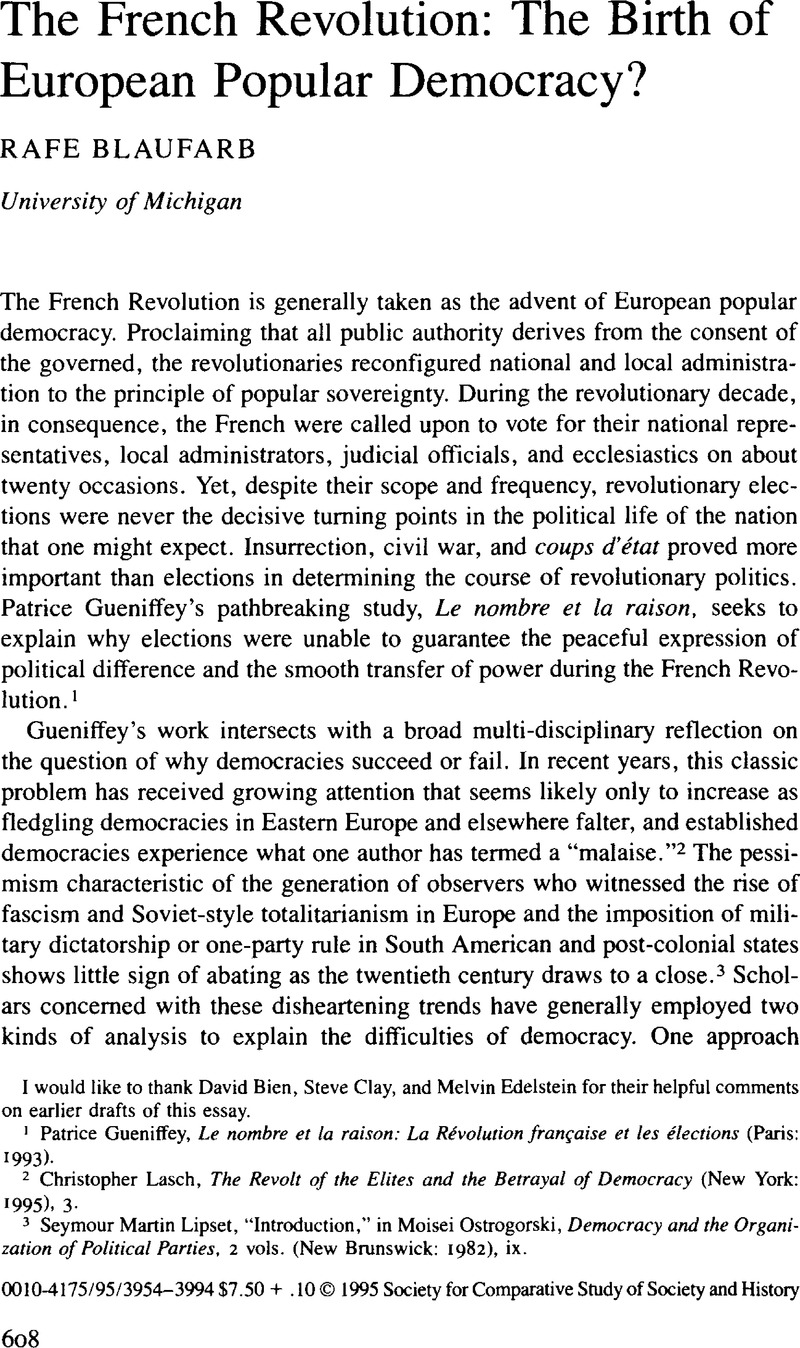Published online by Cambridge University Press: 03 June 2009

1 Gueniffey, Patrice, Le nombre et la raison: La Revolution francaise et les elections (Paris: 1993).Google Scholar
2 Lasch, Christopher, The Revolt of the Elites and the Betrayal of Democracy (New York,: 1995), ix.Google Scholar
3 Lipset, Seymour Martin, “Introduction,” in Moisei Ostrogorski, Democracy and the Organization of Political Parties, 2 vols. (New Brunswick: 1982), ix.Google Scholar
4 Furet sets out his argument in a number of books and articles, the most important of which is Penser la Révolution française (Paris: 1978)Google Scholar, translated into English as Interpreting the French Revolution (Cambridge: 1981)Google Scholar, Forster, Elborg, trans. A more recent expression of his views can be found in La Révolution de Turgot à Jules Ferry, 1770–1880 (Paris: 1988)Google Scholar. Furet's ideas have been the subject of much commentary. Some of the most incisive criticism can be found in Lynn Hunt's review of Furet's book, Penser la Révolution française, in History and Theory (20:3 [1981], 313–23).Google Scholar
5 Malberg, R. Carté de, Contribution à la théorie générale de l'Etat (Paris: 1962), vol. 2, ch. 2, “Le gouvernement representatif.” The citation is from François Furet's preface to Le nombre et la raison, p. vi.Google Scholar
6 Largely associated with the Institut pour I'Histoire de la Révolution Française and the Atelier: voter et Elire pendant la Décennie Révolutionaire, the French historians working on revolutionary elections include Serge Aberdam, Serge Bianchi, Georges Fournier, Bernard Gain-ot, Jean-Pierre Jessenne, and Claudine Wolikow. Great Britain and the United States are represented by Malcolm Crook and Melvin Edelstein, respectively.
7 Gueniffey derives these figures from a certain amount of original research, as well as the work of other historians, primarily Melvin Edelstein. For a complete breakdown of these findings, see Gueniffey (p. 165).
8 Malcolm Crook, Melvin Edelstein, and Georges Fournier. The term is Edelstein's.
9 “Those who built the first political party system in the 1790's mistook parties for factions, assuming that those with whom they differed were disloyal to the nation and its ideals…. The first parties were confused with factions because the modem political party was outside the range of this generation's experience as well as its historical consciousness” (Goodman, Paul “The First American Party System” in Chambers, William Nisbet and Burnham, Walter Dean, eds. The American Party Systems: Stages of Political Development [New York,: 1967]. 90).Google Scholar
10 Hofstadter, Richard, The Idea of a Party Systern: The Rise of Legitimate Opposition in the United States, 1780–1840 (Berkeley: 1970), 90.Google Scholar
11 On the “thesis of circumstances,” see Sutherland, Donald, “An Assessment of the Writings of François Furet,” French Historical Studies, 16:4 (1990), 784–91CrossRefGoogle Scholar; and Woloch, Isser “On the Latent Illiberalism of the French Revolution,” American Historical Review, 95:5 (1990), 1452–70.CrossRefGoogle Scholar
12 On the problem of reaching decisions by voting in a National Assembly composed of deputies who had formerly represented the society of orders, see Bien, David D., “François Furet, the Terror, and 1789,” French Historical Studies, 16:4 (1990), 777–83.CrossRefGoogle Scholar